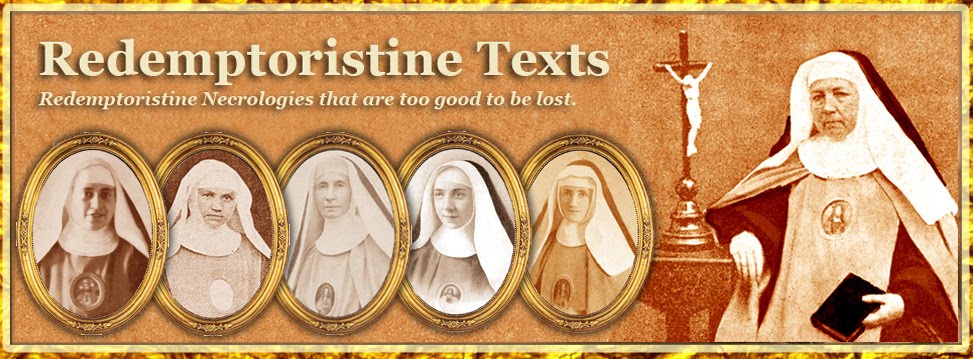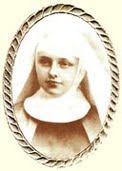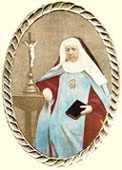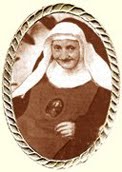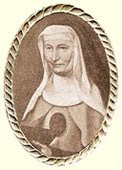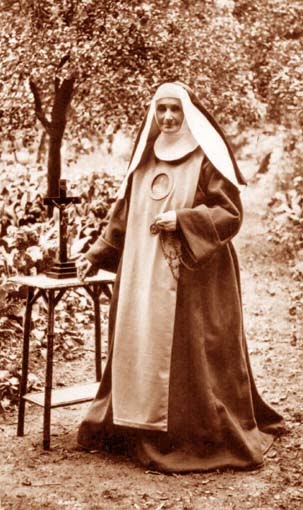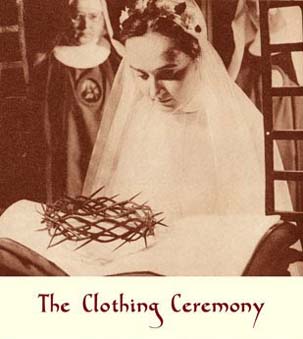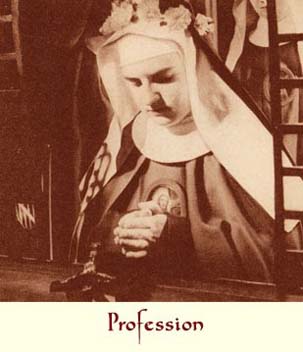God had permitted the religious Orders to be particularly persecuted in Vienna in the 18th Century, but this great capital, in the 19th Century, was to give the signal for their relief. The Emperor Joseph II had pursued them with his hatred, but in the very heart of his court there germinated, without him even suspecting it, vocations that were to give religious life an unexpected flowering.
Marie Anne Ernestine Welsersheimb was born at Graz in Styria on 12th January 1805. She was the grand-daughter of Count Godefroid Suardi, chamberlain to Joseph II. The Countess, her mother, a woman of lofty intelligence and great piety, brought up her eight children in a most Christian manner, her “eight beatitudes” as she called them. Then, when she had assured their future, she entered religion, thirteen years after the death of her husband. This resolution caused a great deal of talk and aroused much astonishment. The noble Christian was content to reply: “If someone goes far away, into a foreign country, to gather a rich inheritance and deprives himself for a few years of the commodities he has enjoyed in the midst of his own family, no one would think of being astonished. So from where does it come that people feel the need to speak to a person who is attracted by the magnificent promises of Our Lord and leaves everything to follow Him, and renounce for just a small number of years the pleasures that the world offers him!”
Marie Ernestine was worthy of such a mother. After smiling for some time on the brilliant world that surrounded her, she studied her vocation under the guidance of a holy religious, the Venerable Father Passerat, and on 4th September 1825, at the age of twenty, she went to rejoin, in the cloister of the Redemptoristines of Vienna, that great Christian who had brought her into the world.[1] Beginning from this moment, a complete transformation was worked in her. In the footsteps of the divine Redeemer she took up her cross and bore it courageously for the space of nearly fifty years.
In fact this life of privations, renunciations and immolation was a long way of the cross that finally ended with a holy death! Marie-Ernestine had scarcely left the world when she exchanged her brilliant home for a very poor convent, and her gentle and tranquil existence gave way to a life of work. First of all she was occupied with poor, abandoned children. She taught these poor children reading writing and arithmetic. When these years of testing had ended, her religious profession (30th January 1832) brought a new task to her who was now called Sister Maria-Victoria of Jesus. Was it not a very heavy cross for a religious of twenty seven years of age to have to direct the educandes? This meant receiving, as they left the world, persons of every age and every condition. It meant helping them to leave behind their ideas, their own habits and their own will. In a word, it meant struggling against habits of life already adopted and substituting others for them. This difficult office was one that Sister Maria-Victoria fulfilled with success. Soon she had to bear a cross heavier still. When she became Mistress of Novices, she had the future of her entire Institute in her hands, but her courage was at the summit of her mission.
However, separations came to add their thorns to cares already so grave. In 1841, Sister Maria-Victoria saw die before her eyes that pious, that heroic mother who, in a manner of speaking, had given her life twice. In the same year, she said farewell to Mother Marie-Alphonse who went to found the convent of the Redemptoristines at Bruges in Belgium. Finally there arrived that year 1848 which was so full of turmoil of every kind. On 6th April, the ferocious mob which had chased out the Redemptorist Fathers and thrown them out onto the highway, including, although they did not know it, Father Passerat, weighed down with his seventy six years, that impious mob laid waste to the nuns’ church, and they too had to seek their salvation in flight.
Once the rabble had been satisfied, the way of the cross continued for Maria-Victoria of Jesus. To the friendly offers of help, seductive to a soul less strong, she replied: “What! Abandon the Institute to which God has called me? Never! Even if I have to walk hundreds of miles on foot, or undergo the most severe privations, I shall seek out my Sisters, and I shall live and die in the midst of them.” She took refuge at Aix-la-Chapelle with six of her Sisters, and accepted the hospitality offered to them by the Sisters of Saint Elisabeth. Then Galoppe, in Holland, became her home. Three years of privations and sufferings did not discourage her. Finally, a beautiful convent, graciously called “Valley of Mary”, Marienthal, replaced the provisional house in 1851. Maria-Victoria was filled with the greatest joy, but the two years that she spent there were once again marked by her devotion to the common cause. She was Mistress of Novices, Consultor, and Secretary to the Superior. There were always responsibilities, and if you wish to call them that, honours, but there was always the cross.
In 1853 we find Sister Maria-Victoria of Jesus at Ried. She was there for eleven years as the Superior of a convent of her Order. The material situation there was precarious, but, in the school of adversity, a courageous soul is hardened against obstacles. And we may say more, she found her strength in the cross itself which crushes less generous souls. The 30th January 1854 was for this Servant of God the 25th jubilee her religious life. It was a triumph of a day, a charming feast which was to give way to new sorrows! For an elevated heart, what pains there were in seeing the concordat between the Holy See and Austria denounced, and the war in Italy open a long series of outrages and atrocious crimes! Sister Maria-Victoria keenly suffered these grave wounds given to the faith, both in her dear homeland and in the whole world, and how great was her sorrow in seeing, after the Council, a sect of “Old Catholics” establishing even at Ried, and almost at the door of the convent, its sacrilegious assizes! The “fiat voluntas” of the divine Saviour in the Garden of Olives presented itself unceasingly in the memory of the Servant of God in the midst of these circumstances. We may say more: after such long trials, after such a sorrowful climb up to Calvary, this last blow was truly her death blow.
In the month of June 1874, Sister Maria-Victoria’s strength suddenly ebbed. From then on she concentrated all her thoughts on her approaching end, and on heaven which she had so long desired. On 20th July, a severe crisis failed to carry her off, but her presence of mind did not abandon her. Her eyes were drawn to a picture hanging on a wall near her bed. This picture represented Saint Joseph expiring in the arms of Jesus and Mary. Soon she cried out in a loud voice: “Sedes sapientiae, ora pro nobis” – “Seat of wisdom, pray for us.” A touching invocation, very beautiful in the face of death, and very worthy of this wise virgin who had so faithfully imitated the Queen of Virgins! It seems that at that moment, the prayer that the dying Sister had so often addressed to Mary was heard as it had been for Saint Alphonsus, as the poor invalid suddenly said to the infirmarian: “My Sister, the Mother of God has just won a victory. I have never had an apparition during my life, and now I have had one at the approach of death.” This means in a few words the last temptations of the demon and the miraculous assistance of the Mother of the Saviour. On the same day of her death, 25th July, with the aid of her Sisters she accomplished all the exercises of her Rule – the examination of conscience, the Rosary, and the Way of the Cross. She received the last sacraments. One last time, she renewed her vows of religion, and then she gently inclined her head like her heavenly Spouse on the cross. She had courageously completed her course, and went to receive the crown of life.
The special character of the interior life of Mother Maria-Victoria seems to have been Christian strength. One of our former novices writes on this subject: “Our good Mistress was a soul full of generosity, and a great friend of mortification. She had a particular talent for leading her novices to the practice of this virtue. Her instructions were ordinarily about the dangers that a soul courts with an unmortified life, and she would express herself on this point in the starkest terms. ‘No,’ she would often tell us, ‘you cannot count on going directly to an easy life in Paradise.’ ‘One of the things she inculcated the most into her novices,’ says Father Hugues, ‘was the habit of combating and subduing their natural inclinations. And so she applied herself to humbling them often and testing the promptitude of their obedience by commanding them those things painful to nature. Moreover she had a favourite maxim which she put into practice: ‘With us,’ she would say, ‘prayer and mortification must march in front. The more we advance in mortification, the more we advance in prayer.’ – ‘We only advance in the love of God,’ she also said to us, ‘to the degree that we hate our own selves. We must hate not this or that employment, but our bad inclinations, our sensuality, our bad humour. This is what we must hate, and hate it for the love of God, because we know that this displeases Him.’
A soul so upright could not fail to feel a tender devotion to the Passion of the Saviour. Sister Maria-Victoria was particularly devoted to the mystery of the Agony in the Garden of Olives. When she was the Superior at Ried, she had a little chapel constructed in the garden. It was furnished with a statue representing Our Lord in His agony and fortified by an angel. Her great consolation in her moments of anguish and perplexity was to go and pray in this chapel. There, prostrate at the feet of her divine Spouse, herself delivered to a mortal sadness, she was persuaded that He could not fail to let a look of commiseration fall upon her and come to her aid. Often, after a prolonged prayer in this blessed spot, she would intone a canticle of thanksgiving and would go back to the house with her heart filled with a holy joy. As a true daughter of Saint Alphonsus, the pious Sister had a tender love for the Blessed Sacrament, the Blessed Virgin and the Saints. In particular she loved the martyr Saints. Without doubt in the midst of her innumerable trials she prayed long and hard to these friends of God. Saint Joseph was also the object of her filial confidence, and this great Saint rewarded her more than once for hoping in him.
The desire for heaven always possessed this beautiful soul. She would often sigh and cry out: “When then shall I arrive there finally to sing the eternal alleluia? Oh, how I rejoice in thinking of the first sight I shall have of eternity.” A holy priest advised her one day to take a remedy that cured her, and then awaited her thanksgiving. “Oh my Father,” she told him, “I cannot be grateful to you for that, for my most ardent desire is to die as soon as possible.” It was with the same sentiments that she wrote to Mother Marie-Alphonse in 1868, who was then gravely ill: “I am happy to learn that the doctor expresses the hope of your recovery. But if I rejoice, it is less for you personally than for your community, as you would wish ardently, I am convinced, to be reunited as quickly as possible with your supreme Good. And so, if I come to hear that you have left this earth, my heart will be sensibly afflicted no doubt, but I should not be able to prevent myself from rejoicing with you, and congratulate myself on having so good an advocate in heaven. We shall act in such a way, believe me, that you will not remain for long at the door of Paradise.”
About six weeks had passed since the death of Mother Maria-Victoria, when two religious consultors fell dangerously ill. Overcome with grief, the Superior felt herself brought to pray during the night at the tomb of the venerated deceased. With great confidence she said the following prayer: “Dear Mother Maria-Victoria, you know through your own experience that a Superior will find herself in pain when the consultors of the Monastery cannot fulfil their office, so help me in my distress and obtain for these two Sisters the recovery of their health.” An astonishing thing! A notable improvement was produced immediately, and at the end of five days the two invalids had entirely recovered. Some months before her last illness, Sister Maria-Victoria had written to the Superior of Marienthal that, if she was the first one to die, she would hope to warn by her death two Sisters who were no longer giving her any sign of life. Then on 23rd July 1874, on the same day of the death of Sister Maria-Victoria, a religious of Marienthal heard, at ten o’clock in the evening, a noise very close to her cell. Suddenly she perceived, standing before her bed, a Redemptoristine nun whom she did not know. The apparition was tall. Her veil was of a dazzling white. Her whole cell, which until then had been plunged in darkness, now became ablaze with light. Coming up to the bed of the invalid, the apparition blessed her and told her: “I have come from Purgatory, where I still endure a sharp pain from these two fingers.” And as she spoke, she showed her the thumb and index finger of her right hand. “I am praying for you,” she added, “so that you may go to Paradise.” Then the vision disappeared. The poor rheumatic, more dead than alive, could not close her eyes the whole night. The next morning she hurried to tell her Superior what had happened to her. Three days later, they received the news at Marienthal that Sister Maria-Victoria had died on 23rd July. On that very day, by God’s permission, she had kept her promise and by her own death she had warned her former companions.
Marie Anne Ernestine Welsersheimb was born at Graz in Styria on 12th January 1805. She was the grand-daughter of Count Godefroid Suardi, chamberlain to Joseph II. The Countess, her mother, a woman of lofty intelligence and great piety, brought up her eight children in a most Christian manner, her “eight beatitudes” as she called them. Then, when she had assured their future, she entered religion, thirteen years after the death of her husband. This resolution caused a great deal of talk and aroused much astonishment. The noble Christian was content to reply: “If someone goes far away, into a foreign country, to gather a rich inheritance and deprives himself for a few years of the commodities he has enjoyed in the midst of his own family, no one would think of being astonished. So from where does it come that people feel the need to speak to a person who is attracted by the magnificent promises of Our Lord and leaves everything to follow Him, and renounce for just a small number of years the pleasures that the world offers him!”
Marie Ernestine was worthy of such a mother. After smiling for some time on the brilliant world that surrounded her, she studied her vocation under the guidance of a holy religious, the Venerable Father Passerat, and on 4th September 1825, at the age of twenty, she went to rejoin, in the cloister of the Redemptoristines of Vienna, that great Christian who had brought her into the world.[1] Beginning from this moment, a complete transformation was worked in her. In the footsteps of the divine Redeemer she took up her cross and bore it courageously for the space of nearly fifty years.
In fact this life of privations, renunciations and immolation was a long way of the cross that finally ended with a holy death! Marie-Ernestine had scarcely left the world when she exchanged her brilliant home for a very poor convent, and her gentle and tranquil existence gave way to a life of work. First of all she was occupied with poor, abandoned children. She taught these poor children reading writing and arithmetic. When these years of testing had ended, her religious profession (30th January 1832) brought a new task to her who was now called Sister Maria-Victoria of Jesus. Was it not a very heavy cross for a religious of twenty seven years of age to have to direct the educandes? This meant receiving, as they left the world, persons of every age and every condition. It meant helping them to leave behind their ideas, their own habits and their own will. In a word, it meant struggling against habits of life already adopted and substituting others for them. This difficult office was one that Sister Maria-Victoria fulfilled with success. Soon she had to bear a cross heavier still. When she became Mistress of Novices, she had the future of her entire Institute in her hands, but her courage was at the summit of her mission.
However, separations came to add their thorns to cares already so grave. In 1841, Sister Maria-Victoria saw die before her eyes that pious, that heroic mother who, in a manner of speaking, had given her life twice. In the same year, she said farewell to Mother Marie-Alphonse who went to found the convent of the Redemptoristines at Bruges in Belgium. Finally there arrived that year 1848 which was so full of turmoil of every kind. On 6th April, the ferocious mob which had chased out the Redemptorist Fathers and thrown them out onto the highway, including, although they did not know it, Father Passerat, weighed down with his seventy six years, that impious mob laid waste to the nuns’ church, and they too had to seek their salvation in flight.
Once the rabble had been satisfied, the way of the cross continued for Maria-Victoria of Jesus. To the friendly offers of help, seductive to a soul less strong, she replied: “What! Abandon the Institute to which God has called me? Never! Even if I have to walk hundreds of miles on foot, or undergo the most severe privations, I shall seek out my Sisters, and I shall live and die in the midst of them.” She took refuge at Aix-la-Chapelle with six of her Sisters, and accepted the hospitality offered to them by the Sisters of Saint Elisabeth. Then Galoppe, in Holland, became her home. Three years of privations and sufferings did not discourage her. Finally, a beautiful convent, graciously called “Valley of Mary”, Marienthal, replaced the provisional house in 1851. Maria-Victoria was filled with the greatest joy, but the two years that she spent there were once again marked by her devotion to the common cause. She was Mistress of Novices, Consultor, and Secretary to the Superior. There were always responsibilities, and if you wish to call them that, honours, but there was always the cross.
In 1853 we find Sister Maria-Victoria of Jesus at Ried. She was there for eleven years as the Superior of a convent of her Order. The material situation there was precarious, but, in the school of adversity, a courageous soul is hardened against obstacles. And we may say more, she found her strength in the cross itself which crushes less generous souls. The 30th January 1854 was for this Servant of God the 25th jubilee her religious life. It was a triumph of a day, a charming feast which was to give way to new sorrows! For an elevated heart, what pains there were in seeing the concordat between the Holy See and Austria denounced, and the war in Italy open a long series of outrages and atrocious crimes! Sister Maria-Victoria keenly suffered these grave wounds given to the faith, both in her dear homeland and in the whole world, and how great was her sorrow in seeing, after the Council, a sect of “Old Catholics” establishing even at Ried, and almost at the door of the convent, its sacrilegious assizes! The “fiat voluntas” of the divine Saviour in the Garden of Olives presented itself unceasingly in the memory of the Servant of God in the midst of these circumstances. We may say more: after such long trials, after such a sorrowful climb up to Calvary, this last blow was truly her death blow.
In the month of June 1874, Sister Maria-Victoria’s strength suddenly ebbed. From then on she concentrated all her thoughts on her approaching end, and on heaven which she had so long desired. On 20th July, a severe crisis failed to carry her off, but her presence of mind did not abandon her. Her eyes were drawn to a picture hanging on a wall near her bed. This picture represented Saint Joseph expiring in the arms of Jesus and Mary. Soon she cried out in a loud voice: “Sedes sapientiae, ora pro nobis” – “Seat of wisdom, pray for us.” A touching invocation, very beautiful in the face of death, and very worthy of this wise virgin who had so faithfully imitated the Queen of Virgins! It seems that at that moment, the prayer that the dying Sister had so often addressed to Mary was heard as it had been for Saint Alphonsus, as the poor invalid suddenly said to the infirmarian: “My Sister, the Mother of God has just won a victory. I have never had an apparition during my life, and now I have had one at the approach of death.” This means in a few words the last temptations of the demon and the miraculous assistance of the Mother of the Saviour. On the same day of her death, 25th July, with the aid of her Sisters she accomplished all the exercises of her Rule – the examination of conscience, the Rosary, and the Way of the Cross. She received the last sacraments. One last time, she renewed her vows of religion, and then she gently inclined her head like her heavenly Spouse on the cross. She had courageously completed her course, and went to receive the crown of life.
The special character of the interior life of Mother Maria-Victoria seems to have been Christian strength. One of our former novices writes on this subject: “Our good Mistress was a soul full of generosity, and a great friend of mortification. She had a particular talent for leading her novices to the practice of this virtue. Her instructions were ordinarily about the dangers that a soul courts with an unmortified life, and she would express herself on this point in the starkest terms. ‘No,’ she would often tell us, ‘you cannot count on going directly to an easy life in Paradise.’ ‘One of the things she inculcated the most into her novices,’ says Father Hugues, ‘was the habit of combating and subduing their natural inclinations. And so she applied herself to humbling them often and testing the promptitude of their obedience by commanding them those things painful to nature. Moreover she had a favourite maxim which she put into practice: ‘With us,’ she would say, ‘prayer and mortification must march in front. The more we advance in mortification, the more we advance in prayer.’ – ‘We only advance in the love of God,’ she also said to us, ‘to the degree that we hate our own selves. We must hate not this or that employment, but our bad inclinations, our sensuality, our bad humour. This is what we must hate, and hate it for the love of God, because we know that this displeases Him.’
A soul so upright could not fail to feel a tender devotion to the Passion of the Saviour. Sister Maria-Victoria was particularly devoted to the mystery of the Agony in the Garden of Olives. When she was the Superior at Ried, she had a little chapel constructed in the garden. It was furnished with a statue representing Our Lord in His agony and fortified by an angel. Her great consolation in her moments of anguish and perplexity was to go and pray in this chapel. There, prostrate at the feet of her divine Spouse, herself delivered to a mortal sadness, she was persuaded that He could not fail to let a look of commiseration fall upon her and come to her aid. Often, after a prolonged prayer in this blessed spot, she would intone a canticle of thanksgiving and would go back to the house with her heart filled with a holy joy. As a true daughter of Saint Alphonsus, the pious Sister had a tender love for the Blessed Sacrament, the Blessed Virgin and the Saints. In particular she loved the martyr Saints. Without doubt in the midst of her innumerable trials she prayed long and hard to these friends of God. Saint Joseph was also the object of her filial confidence, and this great Saint rewarded her more than once for hoping in him.
The desire for heaven always possessed this beautiful soul. She would often sigh and cry out: “When then shall I arrive there finally to sing the eternal alleluia? Oh, how I rejoice in thinking of the first sight I shall have of eternity.” A holy priest advised her one day to take a remedy that cured her, and then awaited her thanksgiving. “Oh my Father,” she told him, “I cannot be grateful to you for that, for my most ardent desire is to die as soon as possible.” It was with the same sentiments that she wrote to Mother Marie-Alphonse in 1868, who was then gravely ill: “I am happy to learn that the doctor expresses the hope of your recovery. But if I rejoice, it is less for you personally than for your community, as you would wish ardently, I am convinced, to be reunited as quickly as possible with your supreme Good. And so, if I come to hear that you have left this earth, my heart will be sensibly afflicted no doubt, but I should not be able to prevent myself from rejoicing with you, and congratulate myself on having so good an advocate in heaven. We shall act in such a way, believe me, that you will not remain for long at the door of Paradise.”
About six weeks had passed since the death of Mother Maria-Victoria, when two religious consultors fell dangerously ill. Overcome with grief, the Superior felt herself brought to pray during the night at the tomb of the venerated deceased. With great confidence she said the following prayer: “Dear Mother Maria-Victoria, you know through your own experience that a Superior will find herself in pain when the consultors of the Monastery cannot fulfil their office, so help me in my distress and obtain for these two Sisters the recovery of their health.” An astonishing thing! A notable improvement was produced immediately, and at the end of five days the two invalids had entirely recovered. Some months before her last illness, Sister Maria-Victoria had written to the Superior of Marienthal that, if she was the first one to die, she would hope to warn by her death two Sisters who were no longer giving her any sign of life. Then on 23rd July 1874, on the same day of the death of Sister Maria-Victoria, a religious of Marienthal heard, at ten o’clock in the evening, a noise very close to her cell. Suddenly she perceived, standing before her bed, a Redemptoristine nun whom she did not know. The apparition was tall. Her veil was of a dazzling white. Her whole cell, which until then had been plunged in darkness, now became ablaze with light. Coming up to the bed of the invalid, the apparition blessed her and told her: “I have come from Purgatory, where I still endure a sharp pain from these two fingers.” And as she spoke, she showed her the thumb and index finger of her right hand. “I am praying for you,” she added, “so that you may go to Paradise.” Then the vision disappeared. The poor rheumatic, more dead than alive, could not close her eyes the whole night. The next morning she hurried to tell her Superior what had happened to her. Three days later, they received the news at Marienthal that Sister Maria-Victoria had died on 23rd July. On that very day, by God’s permission, she had kept her promise and by her own death she had warned her former companions.
AUSPICE DEI GENITRICE MARIA.
Footnotes
Footnotes
[1] See the charming work by Rev. Father Hugues called: Deux religieuses Rédemptoristines [Two religious Redemptoristines], 1 vol. Casterman
This necrology is translated from Fleurs de l'Institut des Rédemptoristines by Mr John R. Bradbury. The copyright of this translation is the property of the Redemptoristine Nuns of Maitland, Australia. The integral version of the translated book will be posted here as the necrologies appear.
